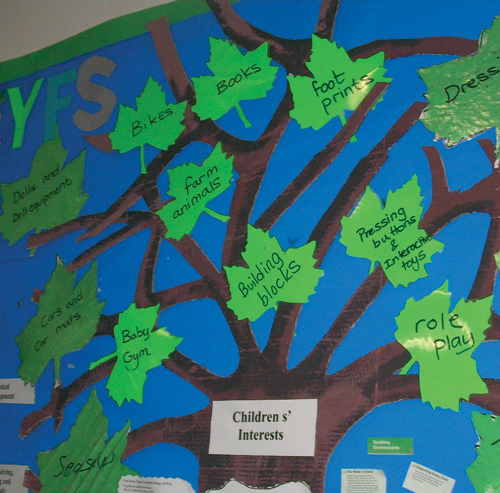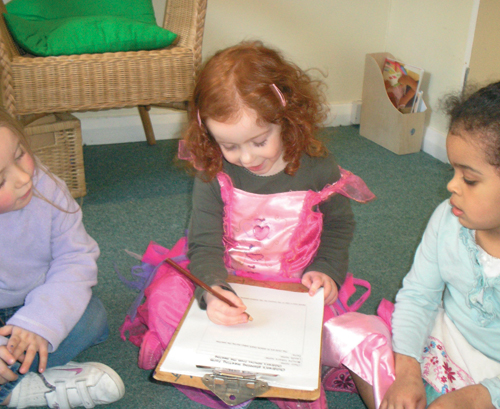Developing an effective and efficient system of planning is vital to being able to provide high-quality early years practice, says Marion Breslin…
In any team it’s critical to find processes that are effective and easily understood by all practitioners, whether senior staff, students or apprentices.
In settings that are full, daycare practitioners get very little non-contact time, so ensuring planning, observation and assessment techniques are as streamlined as possible, while ensuring all areas of the EYFS are covered, is vital.
Even though my setting, Carlton Hill, is part of a larger organisation – London Early Years Foundation (LEYF) – teams are able to develop systems that work within their own particular settings.
We don’t run a room-based system at Carlton Hill; our under-twos have their own floor, and the children from two to five years are together as a family group over the remainder of the building for free play time and only divide up for small focused times.
All children have access to our outdoor area and this provides time for siblings to be together, especially when one is under two years old.
This works really well for us as the older children scaffold the younger children’s learning during free play times and the practitioners are able to plan activities for focus group times dependent on the age group to which they’re allocated.
The same practitioner stays with a set group of children for a four-week period to maintain continuity and development.
In our ‘outstanding’ Ofsted inspection, inspectors were impressed by the systems in place and the team’s knowledge and ability to support the children’s development by following their interests and providing a broad, balanced and stimulating curriculum.
We’ve developed a good balance between child-initiated and adult-led activities, ensuring our ethos of ‘learning through play’ is always maintained.
At various times in our daily routine practitioners are able to have dedicated quiet time with the children in small focus groups to discuss interests and assess learning needs.
We have a combination of age, stage and key group times. Key group time happens once a week, giving practitioners time to spend with their key children, gaining knowledge of their stage of development as well as getting ideas on how to forward plan for each of them as individuals.
It’s during these sessions that the practitioners gain children’s ideas for future planning (see below). We rotate the day each week that practitioners have key group time to ensure the part-time children are also involved in these planning sessions.
At an LEYF ‘sounding’ board, a selection of staff from across the organisation came together to share ideas and a new way of displaying our planning on display boards was discussed.
These are now entitled ‘Interests Trees’. Children’s interests and adult-led activities are displayed as leaves on the tree, which are then followed up with activity plans.

The EYFS principles and commitments are the roots of everything we do, so these are displayed along the bottom of the tree. The interests are changed each week following the children’s planning meetings and key group time.
Some interests only last for a few days, but others may last over a 3–4 week period. Each practitioner is responsible for evaluating their plans and extending this learning in various ways.
As we’re a large, busy nursery it’s very difficult to have weekly team planning meetings. Instead we have a formal planning meeting once a month where we get together to reflect and discuss our practice and the learning taking place in the nursery.
I always plan a team task for these meetings. These can include updating our SEF or our popular policy presentations, where one member of the team reviews an LEYF policy or new local authority guidelines. This ensures policies are not just pieces of paper in a folder but live documents and kept fresh in everyone’s minds.
I feel strongly that our planning is not too prescriptive, meaning we can follow the children’s interests and get them involved in planning and setting up the nursery environment.
However, I’m conscious that to ensure broad and balanced learning practitioners also need to plan adult-led targeted learning opportunities. I feel that we’ve created a system that helps us provide the best care and learning for all our children, in a way that can be implemented by staff and ensures we maintain high-quality practice.
At Carlton Hill, preschool groups participate in planning meetings with the practitioners and discuss what they’d like to learn about over the next week.
The children get the opportunity to put forward ideas and, to aid their development in communication and language, and literacy, one child takes the minutes of the meeting, attempting to write the names of those present and form letters to make words that describe what’s suggested.

Having these discussions with the younger age groups doesn’t always work, so we’re currently working on a more effective way to involve them in this process.
Each time a practitioner sets up an activity or the children create a learning area, eg construction, small world or communication-friendly space, we photograph it. We intend to use these photos as prompts for the younger children for their planning sessions.
Marion Breslin is former nursery manager of Carlton Hill Nursery and Pre-school, run by the London Early Years Foundation.

Nick Sharratt – The power of picture books
Editors picks
